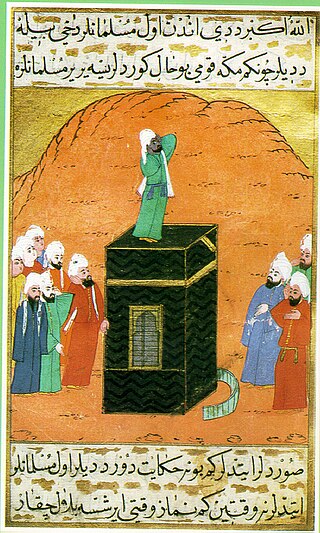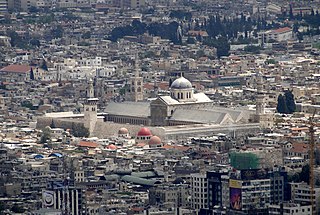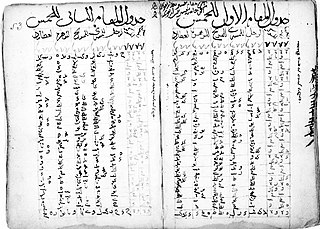
A minaret is a type of tower typically built into or adjacent to mosques. Minarets are generally used to project the Muslim call to prayer (adhan) from a muezzin, but they also served as landmarks and symbols of Islam's presence. They can have a variety of forms, from thick, squat towers to soaring, pencil-thin spires.

The qibla is the direction towards the Kaaba in the Sacred Mosque in Mecca, which is used by Muslims in various religious contexts, particularly the direction of prayer for the salah. In Islam, the Kaaba is believed to be a sacred site built by prophets Abraham and Ishmael, and that its use as the qibla was ordained by God in several verses of the Quran revealed to Muhammad in the second Hijri year. Prior to this revelation, Muhammad and his followers in Medina faced Jerusalem for prayers. Most mosques contain a mihrab that indicates the direction of the qibla.

The muezzin is the person who proclaims the call to the daily prayer (ṣalāt) five times a day at a mosque from the minaret. The muezzin plays an important role in ensuring an accurate prayer schedule for the Muslim community.

A minbar is a pulpit in a mosque where the imam stands to deliver sermons. It is also used in other similar contexts, such as in a Hussainiya where the speaker sits and lectures the congregation.

Taqi ad-Din Muhammad ibn Ma'ruf ash-Shami al-Asadi was an Ottoman polymath active in Cairo and Istanbul. He was the author of more than ninety books on a wide variety of subjects, including astronomy, clocks, engineering, mathematics, mechanics, optics, and natural philosophy.

ʿAbu al-Ḥasan Alāʾ al‐Dīn bin Alī bin Ibrāhīm bin Muhammad bin al-Matam al-Ansari known as Ibn al-Shatir or Ibn ash-Shatir was an Arab astronomer, mathematician and engineer. He worked as muwaqqit in the Umayyad Mosque in Damascus and constructed a sundial for its minaret in 1371/72.

Al-Urdi was a medieval Syrian Arab astronomer and geometer.

The Umayyad Mosque, also known as the Great Mosque of Damascus, located in the old city of Damascus, the capital of Syria, is one of the largest and oldest mosques in the world. Its religious importance stems from the eschatological reports concerning the mosque, and historic events associated with it. Christian and Muslim tradition alike consider it the burial place of John the Baptist's head, a tradition originating in the 6th century. Two shrines inside the premises commemorate the Islamic prophet Muhammad's grandson Husayn ibn Ali, whose martyrdom is frequently compared to that of John the Baptist and Jesus.

Medieval Islamic astronomy comprises the astronomical developments made in the Islamic world, particularly during the Islamic Golden Age, and mostly written in the Arabic language. These developments mostly took place in the Middle East, Central Asia, Al-Andalus, and North Africa, and later in the Far East and India. It closely parallels the genesis of other Islamic sciences in its assimilation of foreign material and the amalgamation of the disparate elements of that material to create a science with Islamic characteristics. These included Greek, Sassanid, and Indian works in particular, which were translated and built upon.

Shams al-Dīn Abū ʿAbd Allāh Muḥammad ibn Muḥammad al-Khalīlī was a Mamluk-era Syrian astronomer who compiled astronomical tables. He worked for most of his life as a muwaqqit at the Umayyad Mosque in Damascus.

Salat times are prayer times when Muslims perform salat. The term is primarily used for the five daily prayers including the Friday prayer, which takes the place of the Dhuhr prayer and must be performed in a group of aibadat. Muslims believe the salah times were revealed by Allah to Muhammad.

Sibt al-Maridini, full name Muḥammad ibn Muḥammad ibn Aḥmad Abū ʿAbd Allāh Badr [Shams] al‐Dīnal‐Miṣrī al‐Dimashqī, was an Egyptian-born astronomer and mathematician. His father came from Damascus. The name "Sibt al-Maridini" means "the son of Al-Mardini's daughter". His maternal grandfather, Abdullah al-Maridini, was a reputed astronomer of the eighth century AH. He was a disciple of the astronomer Ibn al-Majdi, according to tradition.

A zij is an Islamic astronomical book that tabulates parameters used for astronomical calculations of the positions of the sun, moon, stars, and planets.

Medieval Islamic geography and cartography refer to the study of geography and cartography in the Muslim world during the Islamic Golden Age. Muslim scholars made advances to the map-making traditions of earlier cultures, explorers and merchants learned in their travels across the Old World (Afro-Eurasia). Islamic geography had three major fields: exploration and navigation, physical geography, and cartography and mathematical geography. Islamic geography reached its apex with Muhammad al-Idrisi in the 12th century.

A Dar al-Muwaqqit, or muvakkithane in Turkish, is a room or structure accompanying a mosque which was used by the muwaqqit or timekeeper, an officer charged with maintaining the correct times of prayer and communicating them to the muezzin. Dar al-Muwaqqit was the Arabic term given to such structures added to many mosques in Morocco from the Marinid period onward. In the Ottoman Empire the equivalent of such structures were known in Turkish as a muvakkithane.

Abu Ali al-Hassan al-Marrakushi was a Magreb astronomer and mathematician from the Kingdom of Morocco. He was especially important in the field of trigonometry and practical astronomy. He wrote Jāmiʿ al-mabādiʾ wa’l-ghāyāt fī ʿilm al-mīqāt, a treatise on spherical astronomy and astronomical instruments. The first part was translated into French by the orientalist and astronomer Jean Jacques Emmanuel Sédillot during the early 19th century, and published after Sédillot's death.

The Al-Aqsa mosque compound in the Old City of Jerusalem has four minarets in total: three on the western flank and one on the northern flank.

Mustafa ibn Ali al-Muwaqqit, also known as Müneccimbaşı Mustafa Çelebi and Koca Saatçi, was an Ottoman astronomer and author of geography from the sixteenth century. Because of his works on the science of timekeeping and practical astronomy, he is considered "the founder of the Ottoman tradition" of those fields. He was one of the pioneers of astronomy literature in Ottoman Turkish—instead of Arabic which was more common in the Islamic world—following Muhammad al-Qunawi. Since his youth he served as the muwaqqit attached to the Mosque of Selim I in Istanbul, in which capacity he produced most of his writing. In 1560 or later he was appointed to the office of müneccimbaşı, the highest post for astronomers of the Empire.

Muhammad ibn al-Katib Sinan al-Qunawi, also known as Muhammad ibn Yusuf, was an Ottoman astronomer and muwaqqit (timekeeper) in the late fifteenth and early sixteenth century. A pioneer of Ottoman astronomy, especially in the field of astronomical instruments and timekeeping, he served as muwaqqit at various mosques, and eventually at the Sublime Porte under Suleiman the Magnificent. He was influenced by earlier Mamluk astronomers, especially Shams al-Din al-Khalili (1320–1380) and Ibn al-Shatir, as well as by the Central Asian Ali al-Qushji and Al-Biruni.
Ahmad bin Ghulamallah bin Ahmad bin Mahammad, Shihab al-Din al-Kum al-Rishi al-Qahiri was an Egyptian astronomer from Kum al-Rish region in Cairo. So, his nickname among astronomers became Al-Kum al-Rishi. He is considered one of the greatest astronomers of his time, he worked in the art of the stars and began solving zij and writing calendars. He was appointed as a timekeeper at Al-Muayyad Mosque in Cairo.
























